2012 PEUGEOT 4007 warning
[x] Cancel search: warningPage 104 of 236

6
SAFETY
DIRECTION INDICATORS
HAZARD WARNING LAMPS
A visual warning by means of the direction
indicators to alert other road users to a
vehicle breakdown, towing or accident.
HORN
�)
Press one of the spokes of the
steering wheel.
�)
Left: lower the lighting stalk passing
the point of resistance.
�)
Right: raise the lighting stalk passing
the point of resistance.
"Motorway" function
�)
Press briefl y upwards or down-
wards, without going beyond the
point of resistance; the direction
indicators will fl ash 3 times.
Audible warning to alert other road users
to an imminent danger.
The audible signal can be con-
fi gured via the colour screen
"Equipment" menu.
�)
Press this button, the direction indi-
cators fl ash.
They can operate with the ignition off.
Automatic operation of hazard
warning lamps
When braking in an emergency, de-
pending on the deceleration, the hazard
warning lamps come on automatically.
They switch off automatically the fi rst
time you accelerate.
�)
You can also switch them off by
pressing the button.
Page 105 of 236
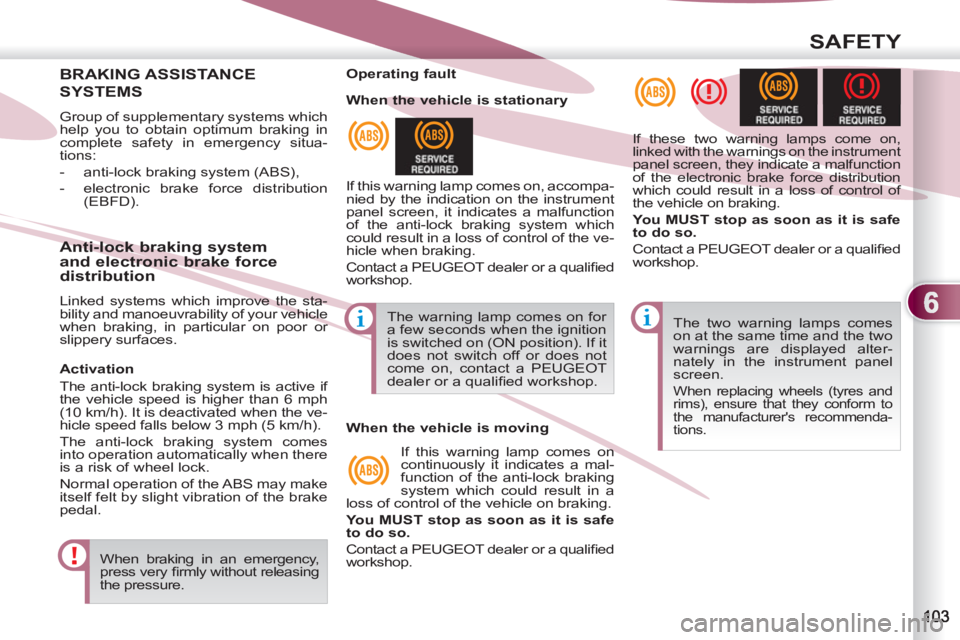
6
SAFETY
BRAKING ASSISTANCE
SYSTEMS
Group of supplementary systems which
help you to obtain optimum braking in
complete safety in emergency situa-
tions:
- anti-lock braking system (ABS),
- electronic brake force distribution
(EBFD).
When braking in an emergency,
press very fi rmly without releasing
the pressure. The two warning lamps comes
on at the same time and the two
warnings are displayed alter-
nately in the instrument panel
screen.
When replacing wheels (tyres and
rims), ensure that they conform to
the manufacturer's recommenda-
tions.
Operating fault
If this warning lamp comes on, accompa-
nied by the indication on the instrument
panel screen, it indicates a malfunction
of the anti-lock braking system which
could result in a loss of control of the ve-
hicle when braking.
Contact a PEUGEOT dealer or a qualifi ed
workshop. If these two warning lamps come on,
linked with the warnings on the instrument
panel screen, they indicate a malfunction
of the electronic brake force distribution
which could result in a loss of control of
the vehicle on braking.
You MUST stop as soon as it is safe
to do so.
Contact a PEUGEOT dealer or a qualifi ed
workshop.
Anti-lock braking system
and electronic brake force
distribution
Linked systems which improve the sta-
bility and manoeuvrability of your vehicle
when braking, in particular on poor or
slippery surfaces. The warning lamp comes on for
a few seconds when the ignition
is switched on (ON position). If it
does not switch off or does not
come on, contact a PEUGEOT
dealer or a qualifi ed workshop.
When the vehicle is stationary
When the vehicle is moving
If this warning lamp comes on
continuously it indicates a mal-
function of the anti-lock braking
system which could result in a
loss of control of the vehicle on braking.
You MUST stop as soon as it is safe
to do so.
Contact a PEUGEOT dealer or a qualifi ed
workshop.
Activation
The anti-lock braking system is active if
the vehicle speed is higher than 6 mph
(10 km/h). It is deactivated when the ve-
hicle speed falls below 3 mph (5 km/h).
The anti-lock braking system comes
into operation automatically when there
is a risk of wheel lock.
Normal operation of the ABS may make
itself felt by slight vibration of the brake
pedal.
Page 108 of 236
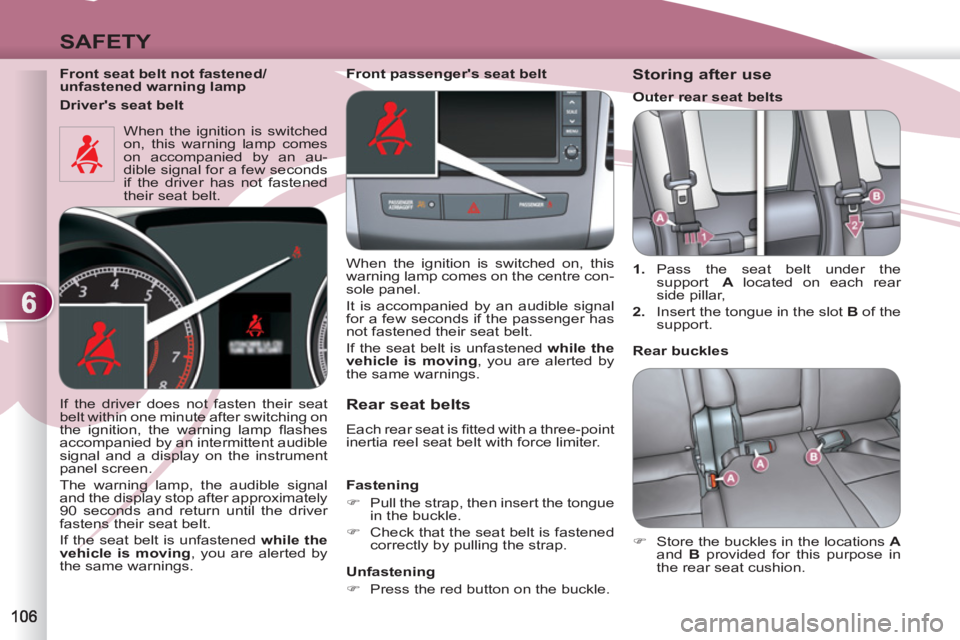
6
SAFETY
Front seat belt not fastened/
unfastened warning lamp
When the ignition is switched
on, this warning lamp comes
on accompanied by an au-
dible signal for a few seconds
if the driver has not fastened
their seat belt.
Rear seat belts
Each rear seat is fi tted with a three-point
inertia reel seat belt with force limiter.
Fastening
�)
Pull the strap, then insert the tongue
in the buckle.
�)
Check that the seat belt is fastened
correctly by pulling the strap.
Unfastening
�)
Press the red button on the buckle.
If the driver does not fasten their seat
belt within one minute after switching on
the ignition, the warning lamp fl ashes
accompanied by an intermittent audible
signal and a display on the instrument
panel screen.
The warning lamp, the audible signal
and the display stop after approximately
90 seconds and return until the driver
fastens their seat belt.
If the seat belt is unfastened while the
vehicle is moving
, you are alerted by
the same warnings.
Storing after use
1.
Pass the seat belt under the
support A
located on each rear
side pillar,
2.
Insert the tongue in the slot B
of the
support.
Rear buckles
�)
Store the buckles in the locations A
and B
provided for this purpose in
the rear seat cushion.
Front passenger's seat belt
When the ignition is switched on, this
warning lamp comes on the centre con-
sole panel.
It is accompanied by an audible signal
for a few seconds if the passenger has
not fastened their seat belt.
If the seat belt is unfastened while the
vehicle is moving
, you are alerted by
the same warnings.
Driver's seat belt
Outer rear seat belts
Page 109 of 236
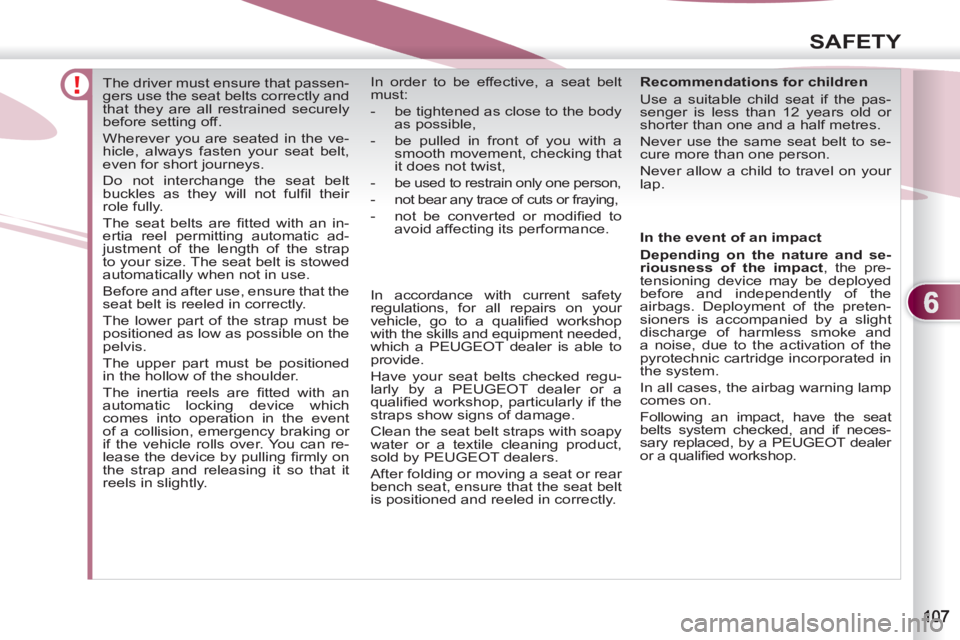
6
SAFETY
The driver must ensure that passen-
gers use the seat belts correctly and
that they are all restrained securely
before setting off.
Wherever you are seated in the ve-
hicle, always fasten your seat belt,
even for short journeys.
Do not interchange the seat belt
buckles as they will not fulfi l their
role fully.
The seat belts are fi tted with an in-
ertia reel permitting automatic ad-
justment of the length of the strap
to your size. The seat belt is stowed
automatically when not in use.
Before and after use, ensure that the
seat belt is reeled in correctly.
The lower part of the strap must be
positioned as low as possible on the
pelvis.
The upper part must be positioned
in the hollow of the shoulder.
The inertia reels are fi tted with an
automatic locking device which
comes into operation in the event
of a collision, emergency braking or
if the vehicle rolls over. You can re-
lease the device by pulling fi rmly on
the strap and releasing it so that it
reels in slightly.
Recommendations for children
Use a suitable child seat if the pas-
senger is less than 12 years old or
shorter than one and a half metres.
Never use the same seat belt to se-
cure more than one person.
Never allow a child to travel on your
lap. In order to be effective, a seat belt
must:
- be tightened as close to the body
as possible,
- be pulled in front of you with a
smooth movement, checking that
it does not twist,
-
be used to restrain only one person,
- not bear any trace of cuts or fraying,
- not be converted or modifi ed to
avoid affecting its performance.
In accordance with current safety
regulations, for all repairs on your
vehicle, go to a qualifi ed workshop
with the skills and equipment needed,
which a PEUGEOT dealer is able to
provide.
Have your seat belts checked regu-
larly by a PEUGEOT dealer or a
qualifi ed workshop, particularly if the
straps show signs of damage.
Clean the seat belt straps with soapy
water or a textile cleaning product,
sold by PEUGEOT dealers.
After folding or moving a seat or rear
bench seat, ensure that the seat belt
is positioned and reeled in correctly.
In the event of an impact
Depending on the nature and se-
riousness of the impact
, the pre-
tensioning device may be deployed
before and independently of the
airbags. Deployment of the preten-
sioners is accompanied by a slight
discharge of harmless smoke and
a noise, due to the activation of the
pyrotechnic cartridge incorporated in
the system.
In all cases, the airbag warning lamp
comes on.
Following an impact, have the seat
belts system checked, and if neces-
sary replaced, by a PEUGEOT dealer
or a qualifi ed workshop.
Page 111 of 236
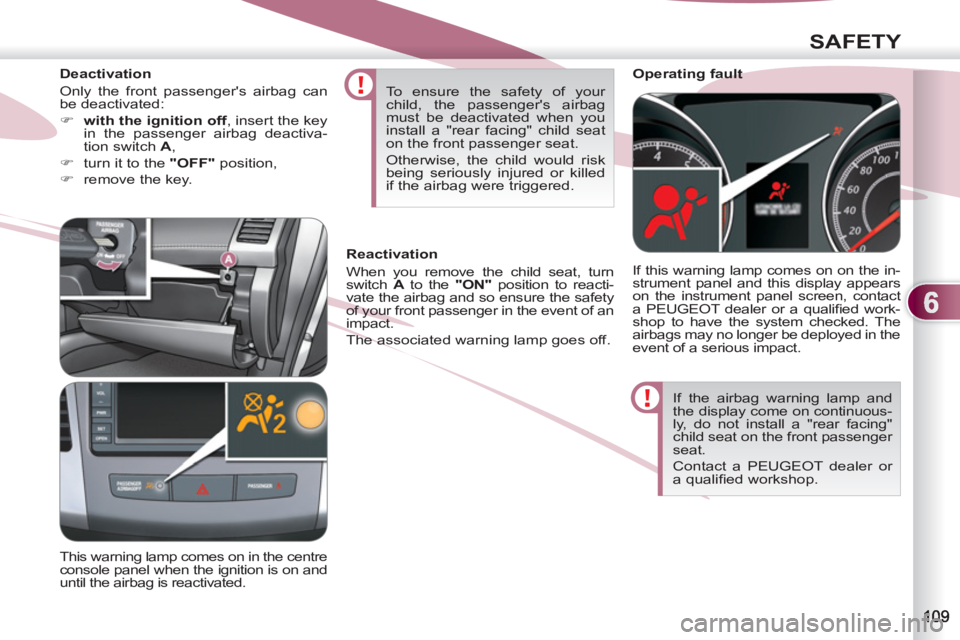
6
SAFETY
If the airbag warning lamp and
the display come on continuous-
ly, do not install a "rear facing"
child seat on the front passenger
seat.
Contact a PEUGEOT dealer or
a qualifi ed workshop.
Operating fault
If this warning lamp comes on on the in-
strument panel and this display appears
on the instrument panel screen, contact
a PEUGEOT dealer or a qualifi ed work-
shop to have the system checked. The
airbags may no longer be deployed in the
event of a serious impact. To ensure the safety of your
child, the passenger's airbag
must be deactivated when you
install a "rear facing" child seat
on the front passenger seat.
Otherwise, the child would risk
being seriously injured or killed
if the airbag were triggered.
This warning lamp comes on in the centre
console panel when the ignition is on and
until the airbag is reactivated.
Reactivation
When you remove the child seat, turn
switch A
to the "ON"
position to reacti-
vate the airbag and so ensure the safety
of your front passenger in the event of an
impact.
The associated warning lamp goes off.
Deactivation
Only the front passenger's airbag can
be deactivated:
�)
with the ignition off
, insert the key
in the passenger airbag deactiva-
tion switch A
,
�)
turn it to the "OFF"
position,
�)
remove the key.
Page 112 of 236
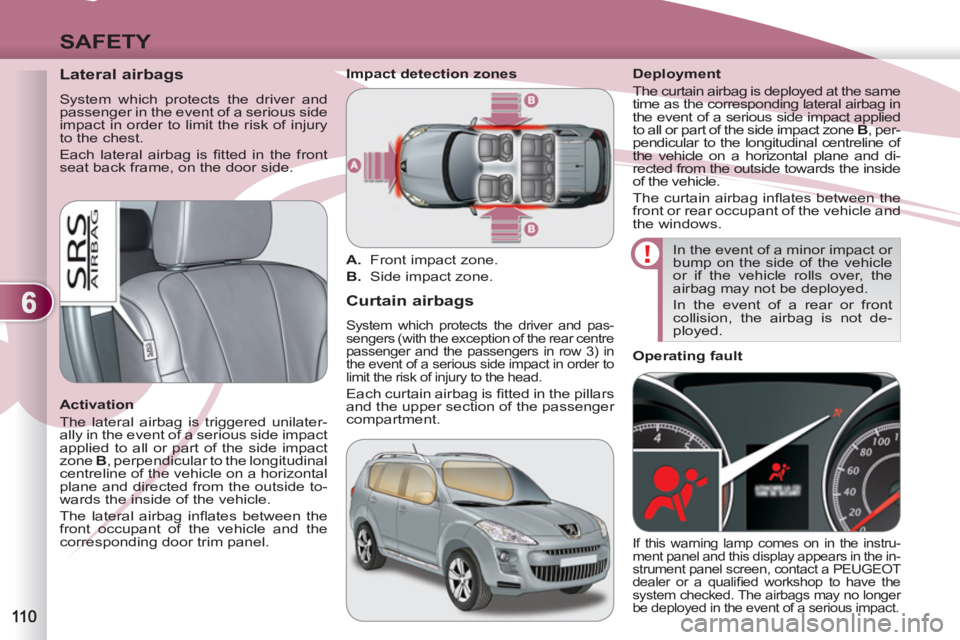
6
SAFETY
Lateral airbags
System which protects the driver and
passenger in the event of a serious side
impact in order to limit the risk of injury
to the chest.
Each lateral airbag is fi tted in the front
seat back frame, on the door side.
Activation
The lateral airbag is triggered unilater-
ally in the event of a serious side impact
applied to all or part of the side impact
zone B
, perpendicular to the longitudinal
centreline of the vehicle on a horizontal
plane and directed from the outside to-
wards the inside of the vehicle.
The lateral airbag infl ates between the
front occupant of the vehicle and the
corresponding door trim panel.
Curtain airbags
System which protects the driver and pas-
sengers (with the exception of the rear centre
passenger and the passengers in row 3) in
the event of a serious side impact in order to
limit the risk of injury to the head.
Each curtain airbag is fi tted in the pillars
and the upper section of the passenger
compartment.
Deployment
The curtain airbag is deployed at the same
time as the corresponding lateral airbag in
the event of a serious side impact applied
to all or part of the side impact zone B
, per-
pendicular to the longitudinal centreline of
the vehicle on a horizontal plane and di-
rected from the outside towards the inside
of the vehicle.
The curtain airbag infl ates between the
front or rear occupant of the vehicle and
the windows.
In the event of a minor impact or
bump on the side of the vehicle
or if the vehicle rolls over, the
airbag may not be deployed.
In the event of a rear or front
collision, the airbag is not de-
ployed.
Impact detection zones
A.
Front impact zone.
B.
Side impact zone.
Operating fault
If this warning lamp comes on in the instru-
ment panel and this display appears in the in-
strument panel screen, contact a PEUGEOT
dealer or a qualifi ed workshop to have the
system checked. The airbags may no longer
be deployed in the event of a serious impact.
Page 120 of 236

7
DRIVING
Operating fault
Reverse gear
Flashing of the indicator R
in the instru-
ment panel screen, accompanied by an
audible signal, indicates a malfunction
on engaging the gear:
Press the brake pedal, position the gear
lever in position N
and engage reverse
gear again.
With the ignition on, if this warning light
comes on, accompanied by vibration
in the pedals and the message "Main-
tenance required"
on the instrument
panel display, this indicates a gearbox
malfunction.
If the message is displayed, carry out
the following operations:
- slow down and stop your vehicle in
a safe place,
- place the lever in position P
or N
,
apply the parking brake and let the
engine run,
- open the bonnet to allow the engine
to cool.
If the message disappears for a long
period, you can set off again.
If the message remains displayed or ap-
pears frequently, contact a PEUGEOT
dealer or a qualifi ed workshop without
delay.
Overheating of the engine may re-
sult in unwanted declutching of the
gearbox.
Page 132 of 236

8
CHECKS
Diesel additive level (Diesel
with particle emission filter)
The minimum level of this additive is indicat-
ed by lighting of the service warning lamp,
accompanied by an audible signal and a
message on the multifunction screen.
Topping up
This additive must be topped up by a
PEUGEOT dealer or a qualifi ed work-
shop without delay.
Waste products
CHECKS
Battery
Check the electrolyte level
regularly. If necessary, top up
the level with distilled water.
Check that the terminals are
clean and correctly tightened,
particularly in summer and winter.
When carrying out work on the battery,
refer to the "Practical information" sec-
tion for details of the precautions to be
taken before disconnecting the battery
and following its reconnection.
Air filter and passenger compartment filter
Refer to the servicing booklet
for details of the replacement
intervals for these compo-
nents.
Depending on the environ-
ment (dusty atmosphere...) and the use
of the vehicle (city driving...), replace
them twice as often if necessary (refer
to the "Engines" paragraph).
A clogged passenger compartment fi l-
ter may have an adverse effect on the
performance of the air conditioning sys-
tem and generate undesirable odours.
Oil filter
Replace the oil fi lter each time
the engine oil is changed.
Refer to the servicing booklet
for details of the replacement
interval for this component.
Particle emission filter (Diesel)
Maintenance of the particle emission fi l-
ter must be carried out by a PEUGEOT
dealer or a qualifi ed workshop.
Following prolonged operation
of the vehicle at very low speed
or at idle, you may, exception-
ally, notice the emission of water
vapour at the exhaust on accel-
eration. This does not have any
adverse effect on the perfor-
mance of the vehicle or on the
environment.
Avoid any prolonged contact of
used oil or fl uids with the skin.
Most of these fl uids are harmful
to health or indeed very corro-
sive.
Do not discard used oil or fl uids into
sewers or onto the ground.
Empty used oil into the containers pro-
vided for this purpose at PEUGEOT
dealers (France) or a qualifi ed work-
shop, or take them to an authorised
waste disposal site.
Do not discard the oil fi lter through
public channels, deposit it in the
containers dedicated to this use in
the PEUGEOT network (France) or
a qualifi ed workshop or take them to
an authorised waste disposal site.
Unless otherwise indicated, check
these components in accordance with
the servicing booklet and in relation to
your engine.
Otherwise, have them checked by a
PEUGEOT dealer or a qualifi ed work-
shop.